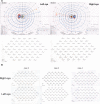Pattern-reversal visual-evoked potential in patients with occult macular dystrophy
- PMID: 21191449
- PMCID: PMC3010000
- DOI: 10.2147/OPTH.S15088
Pattern-reversal visual-evoked potential in patients with occult macular dystrophy
Abstract
Purpose: Occult macular dystrophy (OMD) is a hereditary retinal disease characterized by a normal fundus, normal full-field electroretinograms (ERGs), progressive decrease of visual acuity, and abnormal focal macular ERGs. The purpose of this study was to report pattern-reversal visual-evoked potential (pVEPs) findings in OMD patients.
Patients and method: The pVEPs recorded from four patients with OMD (aged 42-61 years; 2 men and 2 women) were reviewed. The visual acuities ranged from 20/200 to 20/30. The amplitudes of the N-75 and P-100 (P2 amplitude) and the latency of the N-75 components (N1 latency) were analyzed.
Results: The mean (±SD) P2 amplitude was 2.7 ± 1.9 μV for the 5', 4.8 ± 2.9 μV for the 10', 3.2 ± 2.1 μV for the 20', and 4.4 ± 3.5 μV for the 40' checkerboard stimuli. The N1 latency was 122.2 ± 6.4 ms for the 5', 105.0 ± 11.5 ms for the 10', 97.7 ± 10.0 ms for the 20', and 91.0 ± 13.7 ms for the 40' checkerboard stimuli. The mean P2 amplitude was reduced and the N1 latency was delayed in comparison with the laboratory standard for the Keio University Hospital.
Conclusions: The delayed latency and reduced amplitude suggest a major contribution of the central cone pathway to the pVEPs.
Keywords: electroretinogram; occult macular dystrophy; visual-evoked potential.
Figures






References
-
- Miyake Y, Horiguchi M, Tomita N, et al. Occult macular dystrophy. Am J Ophthalmol. 1996;122(5):644–653. - PubMed
-
- Miyake Y, Ichikawa K, Shiose Y, Kawase Y. Hereditary macular dystrophy without visible fundus abnormality. Am J Ophthalmol. 1989;108(3):292–299. - PubMed
-
- Miyake Y. Electrodiagnosis of Retinal Disease. Tokyo, Japan: Springer-Verlag; 2006.
-
- Okuno T, Oku H, Kondo M, et al. Abnormalities of visual-evoked potentials and pupillary light reflexes in a family with autosomal dominant occult macular dystrophy. Clin Experiment Ophthalmol. 2007;35(8):781–783. - PubMed
LinkOut - more resources
Full Text Sources

